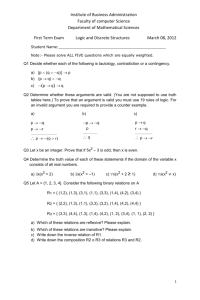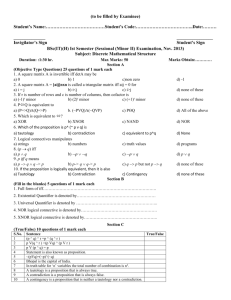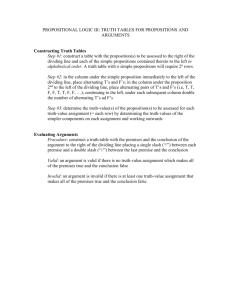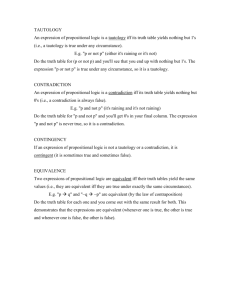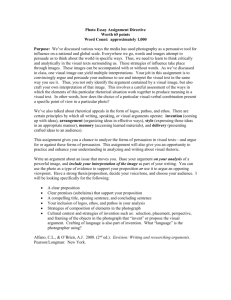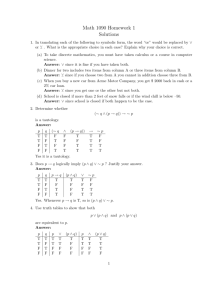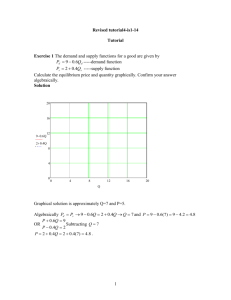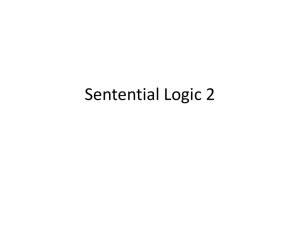Exam 02 For each of the following questions about propositional
advertisement
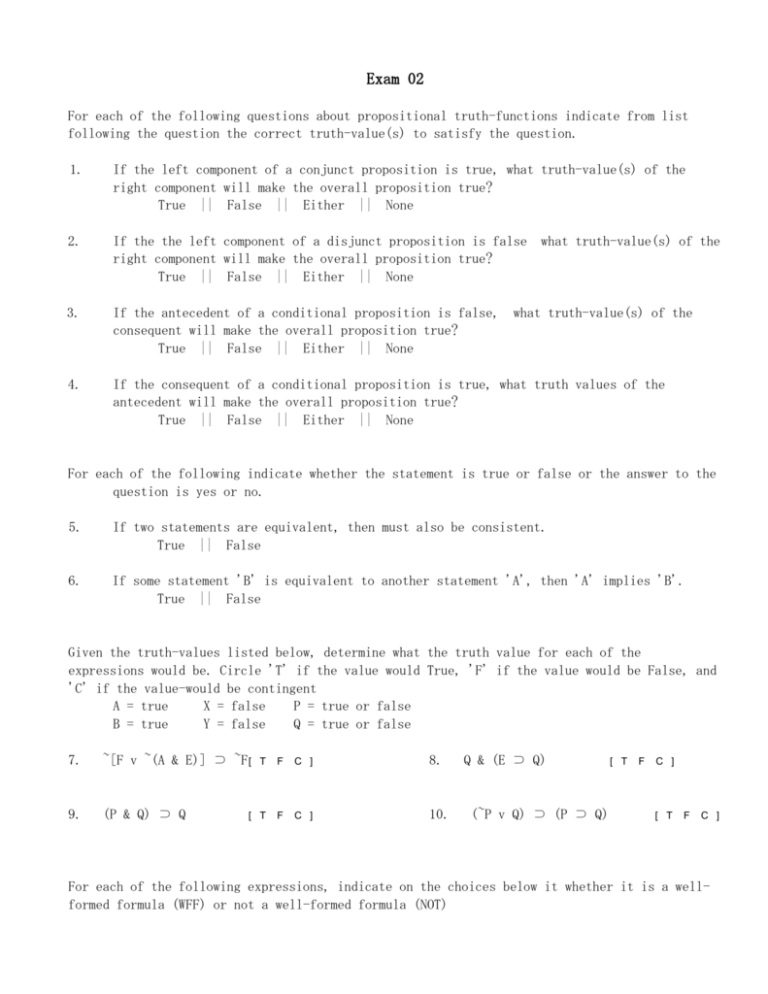
Exam 02
For each of the following questions about propositional truth-functions indicate from list
following the question the correct truth-value(s) to satisfy the question.
1.
If the left component of a conjunct proposition is true, what truth-value(s) of the
right component will make the overall proposition true?
True || False || Either || None
2.
If the the left component of a disjunct proposition is false what truth-value(s) of the
right component will make the overall proposition true?
True || False || Either || None
3.
If the antecedent of a conditional proposition is false, what truth-value(s) of the
consequent will make the overall proposition true?
True || False || Either || None
4.
If the consequent of a conditional proposition is true, what truth values of the
antecedent will make the overall proposition true?
True || False || Either || None
For each of the following indicate whether the statement is true or false or the answer to the
question is yes or no.
5.
If two statements are equivalent, then must also be consistent.
True || False
6.
If some statement 'B' is equivalent to another statement 'A', then 'A' implies 'B'.
True || False
Given the truth-values listed below, determine what the truth value for each of the
expressions would be. Circle 'T' if the value would True, 'F' if the value would be False, and
'C' if the value-would be contingent
A = true
X = false
P = true or false
B = true
Y = false
Q = true or false
7.
~[F v ~(A & E)] ⊃ ~F [
T
F
C ]
8.
9.
(P & Q) ⊃ Q
[ T
F
C ]
10.
Q & (E ⊃ Q)
(~P v Q) ⊃ (P ⊃ Q)
[ T
F
C ]
[ T
F
C ]
For each of the following expressions, indicate on the choices below it whether it is a wellformed formula (WFF) or not a well-formed formula (NOT)
11.
H ⊃ (T v N v G)
P)]
[ WFF | NOT ]
12.
~[~(~W v ~M) & ~E] v ~S
[ WFF | NOT ]
13.
~[(~C v ~D)~(R v
[ WFF | NOT ]
For each of the following expressions use a truth-table to determine whether it is a
tautology, a self-contradiction, or a contingency – circle your choice in the list to the
right of the equation.
14.
~{D v ~[(~Z v D) & Z]}
Tautology || Contradiction || Contingency
15. T ⊃ (S v R)
Tautology || Contradiction || Contingency
16.
~(S v R) ⊃ (~S & ~R)
Tautology || Contradiction || Contingency
17.
[(A v B) & ~A] ⊃ B
Tautology || Contradiction || Contingency
Tautology || Contradiction || Contingency
18. [~(R ⊃ T) v T] v ~R
Use the following truth-table to answer the next two questions.
C, M, L
C ⊃ (M v L)
M ⊃ (C v L)
~C & ~M
~L
1
T
T T
t T
t T t
t T
t T -
Ft F Ft
Ft
2
F
T T
f T
- - -
t T
f T t
Tf F Ft
Ft
3
T
F T
t T
f T t
t T
t T -
Ft F Tf
Ft
4
F
F T
f T
- - -
f T
f T t
Tf T Tf
Ft
5
T
T F
t T
t T f
t T
t T -
Ft F Ft
Tf
6
F
T F
f T
- - -
t F
f F f
Tf F Ft
Tf
7
T
F F
t F
f F t
f T
f F f
Tf T Tf
Tf
8
F
F F
f T
- - -
f T
- - -
Tf T Tf
Tf
Line
19.
Is the argument valid or invalid and how (or by what line) do you know this?
Valid
|| Invalid
How or by what line __________________________
20.
Is the argument inconsistent or consistent, and if it is consistent which line(s)
demonstrate this?
Consistent
|| Inconsistent
By what line (if consistent) ______________________
For each of the symbolized arguments use a truth-table to determine whether the argument is
valid or invalid – circle your choice in the list to the right of the argument.
21.
22.
1.
2.
3.
A ⊃ (B ⊃ E)
A ⊃ (H ⊃ E)
~E
1.
2.
3.
~(K & S)
~K ⊃ M
~S ⊃ M
Valid || Invalid
∴ A⊃ (B v H)
Valid || Invalid
/∴ M
Translate each of the following statements or arguments into propositional logic form.
23.
An angle will get its wings if, and only if, a bell rings.
24.
Unless Sarah can find her way through the labyrinth and outsmart Jareth, the goblin
king, both Sarah and her brother will not see home again.
25.
Willow and Tarra will survive only if Giles can reverse the spell or Buffy can kill the
demon.
Bonus Questions
b1.
If an argument is valid but not consistent, what does that tell you about the premises?
b2.
If an argument is valid but not consistent, what does that tell you about the supporting
relationship of the argument?
…
